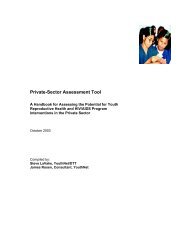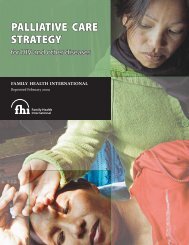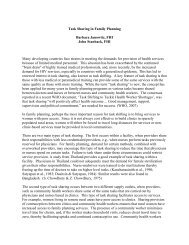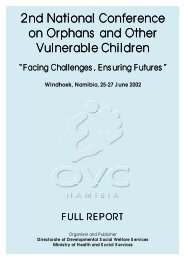National Guidelines for Improving Quality of Care, Support ... - FHI 360
National Guidelines for Improving Quality of Care, Support ... - FHI 360
National Guidelines for Improving Quality of Care, Support ... - FHI 360
Create successful ePaper yourself
Turn your PDF publications into a flip-book with our unique Google optimized e-Paper software.
3) Teamwork: <strong>Improving</strong> quality <strong>of</strong> the system requires that people working in different parts <strong>of</strong><br />
that system to work in a coordinated manner and focusing on realization <strong>of</strong> the same main<br />
goal. Having an effective teamwork requires leadership, participation <strong>of</strong> team members in<br />
analyzing system deficiencies, agreeing on changes to be made and meeting regularly to<br />
evaluate progress.<br />
4) Focus on MVC needs: Be child-focused and household-centered. <strong>Care</strong> and support services<br />
to MVC need to be comprehensive and broad enough to meet all common needs and<br />
expectations <strong>of</strong> the MVC and families<br />
5) Respect the children and their households<br />
6) Do no harm to the child<br />
7) Per<strong>for</strong>m household assessment be<strong>for</strong>e and during intervention in order to identify children<br />
needs (in all the service areas) as well as household status<br />
8) Make required referral <strong>for</strong> the child and linkages <strong>for</strong> services you cannot provide<br />
9) Ensure care and services are coordinated<br />
10) Promote and facilitate family-based care and support<br />
1.7 Dimensions <strong>of</strong> quality<br />
All activities to be implemented in any service area need to be assessed to ensure they are cognizant<br />
<strong>of</strong> the following dimensions <strong>of</strong> quality: 1<br />
Safety The degree to which risks related to care are minimized; do no harm.<br />
Access<br />
The extent to which a service can be reached and utilized. There are no<br />
geographic, economic, social, cultural, organizational and linguistic barriers.<br />
Effectiveness The degree to which desired results or outcomes are achieved.<br />
Technical The degree to which tasks are carried out in accord with program standards<br />
per<strong>for</strong>mance and current pr<strong>of</strong>essional practice.<br />
Efficiency<br />
The extent to which the cost <strong>of</strong> achieving the desired results is minimized so<br />
that the reach and impact <strong>of</strong> programs can be maximized.<br />
Continuity<br />
Compassionate<br />
The delivery <strong>of</strong> care by the same person, as well as timely referral and effective<br />
communication between providers when multiple providers are necessary.<br />
The establishment <strong>of</strong> trust, respect, confidentiality, and responsiveness<br />
relations achieved through ethical practice, effective communication and appropriate<br />
socio-emotional interactions<br />
Appropriateness<br />
Participation<br />
Sustainability<br />
The adaptation <strong>of</strong> services and overall care to needs or circumstances based<br />
on gender, age, disability, culture or socio-economic factors<br />
The participation <strong>of</strong> caregivers, communities, and children themselves in the<br />
design and delivery <strong>of</strong> services and in decision-making regarding their own<br />
care.<br />
The service is designed in a way that it could be maintained at the community<br />
level, in terms <strong>of</strong> direction and management as well as procuring resources,<br />
in the <strong>for</strong>eseeable future.<br />
1 These dimensions <strong>of</strong> quality were adapted from Franco et al (2003).<br />
3
















